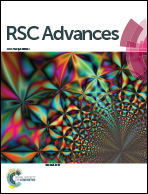Synthesis of highly substituted dihydro-2-oxopyrroles using Fe3O4@nano-cellulose–OPO3H as a novel bio-based magnetic nanocatalyst†
Abstract
A bio-based magnetic nanocatalyst (Fe3O4@nano-cellulose–OPO3H) has been made via immobilization of –OPO3H groups on a Fe3O4@nano-cellulose surface. Fe3O4@nano-cellulose was synthesized by co-precipitation of Fe3+ and Fe2+ salts in an aqueous suspension of nano-cellulose. The catalyst was characterized by FT-IR, FESEM, XRD, TGA, VSM, EDX, XRF and BET. It has been proved that such a heterogeneous catalyst shows high efficiency for the synthesis of dihydro-2-oxopyrrole derivatives via four-component reactions of amines, dialkyl acetylenedicarboxylates and aldehydes under mild reaction conditions. The present procedure is a green and environmental friendly approach that offers many advantages including high yield, easy work-up, simple recovery and reusability of the catalyst.



 Please wait while we load your content...
Please wait while we load your content...